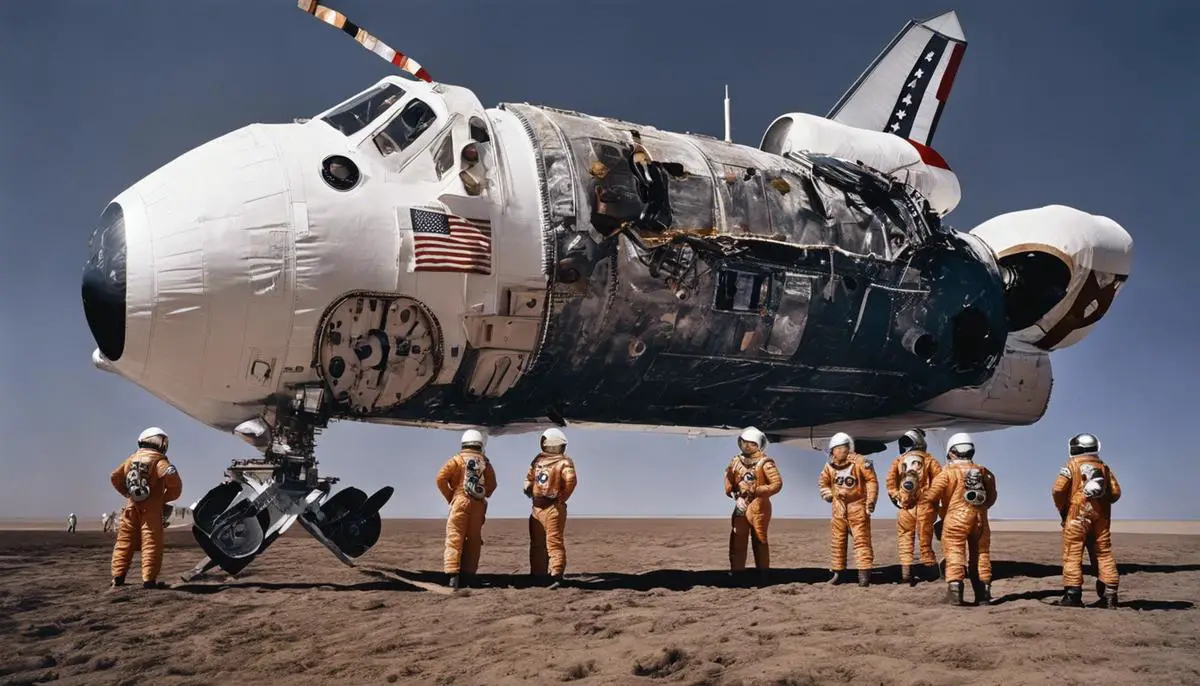In the annals of space exploration, the Apollo 1 mission stands out as a significant moment, not only for its ambitious objectives, but its tragic ending that forever changed the perspective on crew safety and mission planning. This analysis provides an in-depth examination of the Apollo 1 mission, its core objectives, the crew that dared to embark on the unknown, and the tragic fire that marred its progress. Striving beyond mere information, the document shall creatively journey through the resonances of the fire incident’s audio transcript to bring to life its significance both as a historical event and as a lesson for future explorations.
Contents
Overview of the Apollo 1 Mission
The Developmental and Preparatory Phase of the Apollo 1 Mission: A Deep Dive into NASA’s Early Lunar Conquests
In the annals of space exploration, the Apollo 1 Mission holds a singular yet significant space. It is simultaneously a symbol of the indomitable human will to explore the unknown and a grim reminder of the ineffable risks that such a venture entails.
Initiated in 1961 as a part of NASA’s Apollo program, the effectuation of Apollo 1 played itself out over a span of six years. The primary objective, set by President John F. Kennedy, was not the moon landing that popular culture often cites as the be-all and end-all of the Apollo program. Rather, the Apollo 1 mission was envisaged as a manned orbital test of the command and service module – the inaugural tangible step towards achieving lunar exploration.
A meticulous inspection of the development process of Apollo 1 is essential to grasp the complexities of its components and technology. The most revolutionary element in this spacecraft was indisputably the Command Module (CM). Being the primary crew compartment for orbit, re-entry, and ocean recovery, this pressurized vessel offered astronauts a life-supporting environment in space.
The design of the CM, manufactured by North American Aviation, featured a forward docking tunnel and side hatch, with provisions for three astronauts. In terms of controls, the incorporation of rotational hand controllers, event timer, and engine gimbal control made maneuvering an intuitive affair.
Beyond the tangible mechanics, the preparatory phase of Apollo 1 was an intense period of simulations and training for astronauts Gus Grissom, Ed White, and Roger Chaffee. Often overlooked in popular discourse, the rigorous training regime ranged from procedural review to comprehensive simulations that accounted for every foreseeable challenge during the mission.
In essence, the Apollo 1 mission was a daring testament to humankind’s relentless pursuit of the unknown. It was a venture that underscored not just the technical prowess and logistical planning capacity of NASA, but also the courage and tenacity of the astronauts who realized these cosmic ambitions.
Yet in every reckoning of the Apollo 1 Mission, a heartfelt tribute must be paid to the human cost. The tragic fire during a launch pad test that claimed the lives of the brave Apollo 1 crew members—Gus Grissom, Ed White, and Roger Chaffee—serves as a resounding reminder of the high stakes involved in this grand cosmic quest.
The Apollo 1 Mission was not just a prologue to the more celebrated chapters of the Apollo Program. It was a profound lesson in courage, sacrifice, and the multitudes of challenges and risks space exploration encompasses. A critical exercise in understanding how the developmental and preparatory phase unfolded offers an illuminating lens into all that space travel entails and delivers profound insights into the critical importance of precautions and safety measures in such a high-risk exploration arena.

The Day of the Apollo 1 Fire
Decoding the Audio Chronicles: The Tragic Demise of Apollo 1
Building upon our understanding of the Apollo 1 mission’s design intricacies, objectives, and the mankind’s ambition to unravel the universe’s mysteries, we now turn our attention to the climactic unraveling of the heartbreaking catastrophe. The true depth of the calamity can be comprehentially discerned through a meticulous analysis of the incendiary moments captured in the audio transcript.
January 27, 1967, the day of the “plugs-out” test marked a grim episode in the annals of human space exploration. Geared towards mirroring actual launch conditions, this test was meant to be a stepping stone leading to the culmination of countless hours of labor, trials, and simulations undergone by astronauts Lt. Col. Virgil I. Grissom, Lt. Col. Edward H. White II, and Roger B. Chaffee.
Contrary to the anticipated outcome, this test witnessed an inferno claiming the lives of the brave souls within the confines of the Command Module. The audio transcript provides a chilling account of the tragic events that unfolded within the span of mere minutes.
Circulated reports at the time observe that the audio transcript commenced with procedural exchanges between the crew and ground personnel, reflecting navigation system calibration, module ventilation checks, and pressurization tests. Approximately 10 hours into the test, we come across Grissom’s commentary about a ‘strange smell,’ nearly an hour prior to the fire outbreak. This was followed by inquiries surrounding communications hiccups and intermittent static.
Approximately 18 minutes prior to the end of the recordings, an alarmingly urgent comment from one of the astronauts, believed to be Chaffee, cries out, “Fire, I smell fire.” What transpires next, is a chilling sequence of frantic exchanges and spikes in telemetry parameters, while the crew clamored desperately to open the inward-opening hatch.
Unfortunately, the intricately designed Command Module, for all its technological prowess, proved to be a tragic snare. Incapable of accommodating swift evacuation under such intense conditions, the hatch held firm, resulting in the smothering demise of Grissom, White, and Chaffee.
The audio transcript tragically concludes with a powerful radio silence, following a span of 17 seconds of frantic communication attempts by ground control.
Probing into this audio account is akin to lifting the shroud over a long-withstanding enigma. It gives us a hard-hitting vantage point to examine the fatal inferno that occurred in the Apollo 1 capsule, forever reminding us of the dire risks and repercussions synonymous with mankind’s quest for cosmic discovery.
Bringing this analysis to a close, it is imperative that we reflect on the human courage and pursuit of innovation, exemplified by the Apollo 1 crew, while also acknowledging the catastrophic price paid for it. It is through such retrospection that we can truly enrich future pursuits of knowledge and exploration.

Analysis of the Apollo 1 Fire Audio Transcript
The audio transcript of the Apollo 1 fire is of monumental historical importance, offering a heart-wrenching window into humanity’s brush with tragedy during our pursuit of cosmic knowledge.
On the fateful day of the tragedy – January 27, 1967, the Apollo 1 crew, Gus Grissom, Ed White, and Roger Chaffee, were performing a “plugs-out” test, an integral part of the mission preparations, simulating real launch conditions. The audio transcript of this test has served as a time capsule via radio waves, bridging the gap between that ill-fated day and the present.
The analytical context of the transcript reveals a detailed procedural exchange between the astronauts and its ground control. These exchanges offer unprecedented insights into the operations at the vanguard of our exploration expeditions, from technical procedures to the control language used amongst teams.
Amidst the mundane communications, the astronauts reported an unusual smell in their suits – a premonition barely registered in the normal course of dialogues. Minutes later, when the audio began to glitch due to communication errors, the foreboding unfurled itself.
Moments before disaster struck, the transcript reveals frantic exchanges, giving us chilling echo of the fire outbreak within the Command Module (CM). The study of these exchanges provides an intimate understanding of the escalating peril that the crew experienced, and the desperate attempts to quell it.
One of the revelations of this transcript analysis is the inability to open the hatch due to design configurations, resulting in the heroic crew members’ tragic end. The audio abruptly descending into silence paints a poignant picture of the struggle against an unrelenting adversary within the confines of the CM.
Post-fire, the transcript turns into futile communication attempts from ground control – a stark contrast to the earlier purposeful exchanges. This radio silence amplified the magnitude of loss.
The detailed analysis of Apollo 1’s fire audio transcript is more than an account of a tragic event. It serves as a wakeup call to the inherent risks associated with mankind’s thirst for space exploration. In the transcriptions of hurried words and ensuing silence – we are reminded of the price paid for innovation, discovery and knowledge.
As scholars and enthusiasts alike delve into the analysis of the transcript, it becomes our collective duty to remember and honor the bravery, and insatiable curiosity that defined the Apollo 1 crew. A courage, mirrored, in every astronaut that followed. Their sacrifice added fuel to the rocket engines propelling us towards the stars. It is through studies like these, we remember not only the glory of triumph, but also the courage in facing tragedy; for each silent moment etched in the transcript, echoes into the annals of space exploration, reminding us of the gravity and honor of this infinite quest.

Implications and Learnings from the Apollo 1 Fire
The incident of Apollo 1, as disheartening as it was, proved to be a catalyst for paradigmatic shifts in NASA’s safety protocols, design standards, and operating procedures. A deep dive into the available audio transcript provides several revelations about the mission’s ill fate that, unfortunately, led to the loss of three brilliant astronauts: Command Pilot Virgil I. “Gus” Grissom, Senior Pilot Ed White II, and Pilot Roger B. Chaffee.
Undeniably, the spoken word, particularly in extreme situations, remains an excellent source of unedited direct information. Audio transcripts, especially ones portraying life-or-death circumstances like the Apollo 1 fire, though harrowing, are inestimably important for understanding the sequence of events, responses, and problems that transpired. The Apollo 1 audio transcript comprises detailed procedural exchanges between the crew and ground control. These exchanges, prior to and during the fire, reveal multiple cues about the command module’s internal environment and the crew’s increasingly frantic condition.
An unusual commentary about a strange smell from one of the suits is noteworthy. Identified within seconds before the fire by the crew, it hints at potential technical undetected issues and emphasizes the need for enhanced environmental control and life support systems. The fire, which broke out unexpectedly during the “plugs-out” test, was communicated rather frantically by the crew but lost in the chaos was an alarmsome pointer of how quickly emergencies can occur in space-bound vessels and the critical need for instantaneous responses.
The subsequent inability to open the hatch due to its design configuration turned the command module into a veritable death trap. The detailed analysis of this situation led to significant alterations in the design and operating mechanisms of hatches, making them inward opening rather than outward and reducing the number of actions required to open them.
The post-fire period, marked by radio silence and painstakingly futile communication attempts from ground control, underscores the importance of fail-safe communication systems and advanced fire-suppression tools within the spacecraft for the astronauts’ survival.
Reflecting on this incident prompts deeper contemplation about the inherent risks accompanying mankind’s ambitious quest towards cosmic exploration. The bravery, curiosity, and lives of the Apollo 1 crew members were tragically lost to a confluence of avoidable technical and procedural oversights. Yet, their ultimate sacrifice marked a watershed moment in space exploration. The lessons borne from this incident were not confined to NASA alone; they reverberated throughout the global aeronautical community, setting new industry-wide standards in safety, design, testing, and operational procedures.
In conclusion, the Apollo 1 incident, reinforced by the heart-wrenching recollections in the audio transcript, fundamentally transformed safety perspectives in piloted space missions. It serves as a stern reminder that even with our heads in the stars, meticulous caution, relentless review, and dutiful recognition of potential faults on the ground can stave off tragedies on the way to the heavens.

As we delve into the echoes of the past and the profound implication of the Apollo 1 fire, we are reminded of the strength of the human spirit, the quest for knowledge, and the lessons of history. Such critical analysis of the Apollo 1 fire audio transcripts provides us with valuable insights into the emotions, reactions, and emergency management at that heart-wrenching moment. Furthermore, it also unravels the string of transformations embedded in the very fabric of space exploration and astronaut safety training following the incident. Indeed, the Apollo 1 tragedy and its aftermath serve as a lodestar, guiding the footsteps of present-day spacefarers and mission planners.
